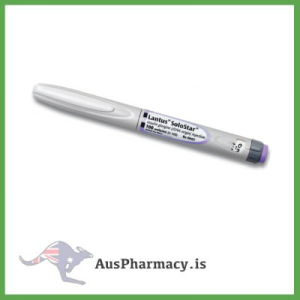Understanding the Lantus Insulin 3ml Pen: Educational Guide on Basal Insulin and Diabetes Care
Introduction
The Lantus Insulin 3ml Pen represents a vital innovation in diabetes management, designed for individuals who require long-acting insulin therapy. This pen provides an accurate and convenient way to deliver insulin glargine — a form of human insulin analog that helps maintain stable blood glucose levels over 24 hours. In an educational context, learning about how this pen functions, its proper use, and its role in diabetes care is essential for students, healthcare trainees, and patients seeking knowledge.
1. What is Lantus Insulin?
Lantus is the brand name for insulin glargine, a synthetic long-acting insulin analogue developed to mimic the body’s natural basal insulin secretion. Unlike rapid-acting insulins that act within minutes, Lantus provides a slow and steady release of insulin into the bloodstream, maintaining glucose control between meals and overnight.
Educationally, understanding its pharmacology helps explain how consistent basal insulin levels contribute to stable glycemic control. Lantus is typically prescribed for individuals with Type 1 or Type 2 diabetes who require insulin therapy to manage their condition effectively.
2. Composition and Mechanism of Action
Each Lantus Insulin 3ml Pen contains:
-
Insulin glargine (100 IU/ml)
-
Excipients like glycerol, zinc chloride, and water for injection
When injected subcutaneously, insulin glargine forms microprecipitates that slowly dissolve, releasing small amounts of insulin continuously. This provides up to 24-hour coverage without pronounced peaks, reducing the risk of hypoglycemia (low blood sugar). For students of pharmacology or endocrinology, this mechanism illustrates the concept of steady-state insulin kinetics.
3. Educational Uses in Diabetes Training
In medical and nursing programs, Lantus pens are often used as models for:
-
Demonstrating insulin injection techniques
-
Understanding insulin pharmacodynamics
-
Practicing dose adjustment and timing
-
Explaining patient education in diabetes care
Learning the correct injection method — including site rotation, priming, and dose dialing — forms part of patient education and healthcare professional training.
4. How the Lantus Pen Works
The Lantus 3ml pen is a pre-filled insulin device that simplifies administration by eliminating the need to draw doses from a vial.
Educationally, understanding its structure and usage is important:
-
Cap: Protects the needle and pen tip
-
Dose dial: Allows users to set the correct insulin dose
-
Injection button: Releases the insulin
-
Cartridge window: Shows remaining insulin
Students can practice injection techniques on training models to gain hands-on experience before assisting real patients.
5. Importance of Accurate Dosing
Proper insulin dosing is critical for preventing both hyperglycemia (high blood sugar) and hypoglycemia (low blood sugar). The Lantus pen’s fine dose dial helps ensure precision. In educational settings, students are taught:
-
How to calculate the correct insulin dose
-
The importance of consistent injection timing
-
Monitoring blood glucose before and after injection
Pharmacy and nursing programs emphasize dose education as part of safe insulin administration practices.
6. Storage and Handling
Proper storage is another vital aspect of insulin education.
-
Before use: Store refrigerated (2–8°C).
-
After first use: Keep at room temperature (below 30°C) for up to 28 days.
-
Avoid freezing or direct sunlight.
These details are critical for maintaining insulin potency and ensuring accurate clinical outcomes.
7. Comparing Lantus with Other Insulins
Understanding how Lantus differs from other insulins is essential for medical and pharmacy students.
For example:
-
Rapid-acting insulins (like Humalog or Novorapid) act within 15 minutes.
-
Intermediate-acting insulins (like NPH) last 12–16 hours.
-
Lantus, by contrast, offers a 24-hour steady release.
This makes it ideal for maintaining basal insulin coverage with once-daily injections.
8. Patient Education and Awareness
Educational discussions about insulin therapy often focus on empowering patients with knowledge. Topics include:
-
Recognizing signs of low or high blood sugar
-
Maintaining regular meal schedules
-
Performing self-monitoring of blood glucose (SMBG)
-
Proper disposal of used needles
Students are also trained to communicate effectively with patients, ensuring they understand insulin use and safety.
9. Benefits of Using the Lantus Pen
-
Accuracy: Allows precise dosing in small increments.
-
Convenience: Ready-to-use, pre-filled design.
-
Safety: Reduces contamination risks associated with vials and syringes.
-
Consistency: Provides stable glucose control over 24 hours.
Educators often highlight how such devices improve patient adherence to insulin regimens.
10. Key Safety Guidelines (Educational Summary)
Students must remember:
-
Always verify insulin type and concentration before injection.
-
Never share insulin pens.
-
Inspect insulin clarity before use — discard if cloudy.
-
Rotate injection sites to prevent lipodystrophy.
-
Follow healthcare guidance on dose timing and monitoring.
11. The Role of Technology in Insulin Delivery
Modern insulin pens like Lantus represent a fusion of medical engineering and pharmacology. Understanding how these tools evolved — from glass syringes to smart pens — helps future healthcare professionals appreciate innovations improving diabetes management globally.
12. Conclusion
From an educational standpoint, the Lantus Insulin 3ml Pen serves as an essential teaching tool in diabetes management. Its ease of use, steady release profile, and patient-friendly design make it a cornerstone example for students studying endocrinology, pharmacotherapy, and nursing care.
Learning how insulin glargine functions helps professionals and learners alike understand the delicate balance between insulin action, diet, and blood glucose control — key knowledge for delivering effective, safe, and compassionate diabetes care.





